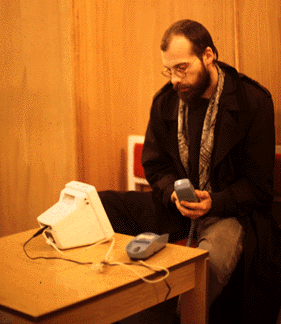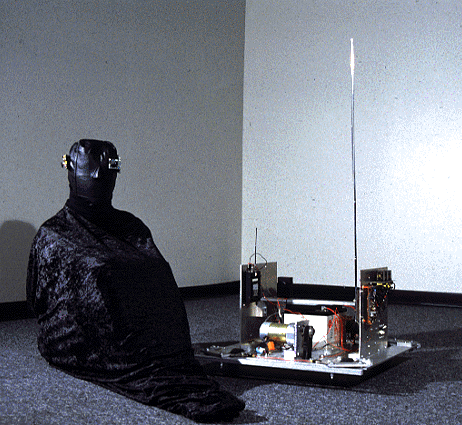
On October 5, 1996, Ed Bennett and I participated in the IV Saint
Petersburg
Biennale with a telepresence event entitled "Ornitorrinco in the
Sahara".
Realized in a public area of a downtown building in Chicago, The
School
of the Art Institute, without any prior announcement to facilities
users,
the event consisted basically of three nodes linking the downtown
site
in real time to The Saint Petersburg History Museum (a Biennale
sponsor)
and the Aldo Castillo Art Gallery, located in the well known
Chicago gallery
district. Through these telecommunications ports of entry human
remote
subjects interacted with one another by projecting their wills and
desires
onto equally remote and fully mobile, wireless telerobotic and
telecyborg
objects.

Dmitry Shubin
in St. Petersburg, Russia,
with the videophone used in
Ornitorrinco in the Sahara
One of the Saint Petersburg Biennale directors, Dmitry Shubin, used a black and white videophone to control (from the The Saint Petersburg History Museum) the wireless telerobot Ornitorrinco (at The School in Chicago) and to receive feedback (in the form of sequential video stills) from the telerobot's point of view. At the same time, my own body was enveloped by a wireless telepresence garment (1) which transformed it into a blind polimorphic zombie-like cyborg--a zomborg. The dispossessed human body was controlled, via a telephone connection only, by artist and art historian Simone Osthoff--who experienced empathic telematic blindness--from the Aldo Castillo Gallery. The color video feed from the zomborg was transmitted live to another space in the downtown Chicago building, enabling local viewers, surprised and unaware of the situation, to see the dialogical experience in real time (from the point of view of the zomborg). During the event, as the human body was remote-controlled in the same manner the telerobotic body was, a unique dialogical telepresence situation unfolded.

The telerobot Ornitorrinco and the teleborg
interacting as they were simultaneously
remote controlled from the
the St. Petersburg Biennale and
the Aldo Castillo Gallery.
Photo: Anna Yu
The telepresence garment consisted basically of a transmitter
vest (which placed the video transmitter in direct
contact with
the skin under the cloth), a limbless suit
(which
eliminated proprioception), and a transceiver
hood
with no openings for eyes or mouth on which I sew
circuit boards
to transmit video and receive audio. The CCD camera was mounted in
alignment
with my left eye and the audio receiver was mounted in alignment
with my
right ear. With this garment the human subject was converted into
a human
object, becoming a direct conduit to a remote operator's commands.
The
human body could not see anything at all. It could barely hear,
and with
great difficulty it could emit sounds. Locomotion on all fours was
dramatically
disabled by the limbless suit. With this garment, breathing became
an exercise
in patience, and as the temperature rose, sweat dripped
incessantly, and
most senses were effaced or had their range and power reduced. The
human
body could only rely on instinct and the concern and cooperation
of the
remote agent. The feelings that emerged in this dialogical context
were
a sense of spatial unawareness and fear of getting harmed, an
agonizing
combination of feeling invisible and fragile simultaneously. Like
a corpse
revived by an external power, my motions were not proprio motu.

The teleborg and the telerobot Ornitorrinco
Photo: Anna Yu
In previous telepresence installations, Ed Bennett and I explored
the concept
of geographic displacements (2), which we also pursued in this
piece. Without
ever leaving Chicago, in the past the telerobot Ornitorrinco went
to the
legendary beach of Copacabana, the inaccessible terrestrial Moon,
and the
mythic Garden of Eden. This time, it went to the inhospitable
Sahara. The
title of this event, "Ornitorrinco in the Sahara", dealt wryly
with the contradictions inherent in the oppositions between a
mostly barren
land visited by few and the public space of a downtown building,
early
in the morning on a weekend day, in one of the largest American
cities.
The event took place early in the morning because of the
Chicago-St. Petersburg
9-hour time zone difference. The sense of isolation, as well as
nomadic
activity, conveyed by the African desert, were translated into the
telenomadic
experience of the remote subjects and echoed in my own sense of
complete
isolation as a host to someone else's volition.

Simone Osthoff
at Aldo Castillo Gallery, Chicago,
from where she controlled
the body of the zomborg
Photo: Stephen Sinsley
As Simone Osthoff controlled the behavior of my body, I dreaded
the
moment I would hit a wall or a pillar, fall into an open elevator,
or collide
with passersby or the telerobot (which hosted Shubin). Also
temporarily
teleblind (i.e., without visual feedback) and considerate of my
sensorial
deprivation, Osthoff spoke slowly and paused intermittently,
commanding
the body as if via a telempathic sense of touch, as when someone
enters
a dark space and tries hesitantly to touch surrounding objects
hoping to
regain spatial awareness of the environment. At first completely
unaware
of what he was contemplating, Shubin alternated the behavior of
his telerobotic
host between propelling itself down the hall to navigate other
areas of
the space and engaging the zomborg directly. On occasion, physical
contact
between the telerobot and the zomborg occurred.
Cybernetic life, with its shortcomings, drawbacks, and political
ramifications,
as well as its latent expansion of human potentialities, is a
motive power
of our rootless and ahistorical nomadism. If there is today a
general feeling
of artistic openness in the one-world of global information
exchange, partially
shaped by ubiquitous electronic media and greater visa-free
mobility, and
immigration, at the same time most of art is still a matter of
commerce
of objects. The philosophical stasis created by this view of art
conflicts
with the fluidity of personas and commutation of points of view
now enabled
by the post-cold war global economy. The au courant
general feeling
bespeaks the credo that innovation is passé, trying to close the
chapter on high modernism. The serious danger of this position is
to blindly
dismiss the differentia specifica of most radical directions in
electronic
art as anomalies and aberrations in a global market of
postmodernist polyphonic
styles. In this sense, it is imperative to undo the
authoritarianism of
formal aesthetic concerns and assert alternatives that make
statements
about the human condition directly on the flesh. Reflecting on the
passage
into a digital culture and escaping from rubrics that categorize
past directions
in contemporary art--such as body art, installation, wearable art,
happening,
video art, performance, and conceptual art--the dialogical
telepresence
event described above contributed to a relativistic view of
contemporary
experience at the same time that it created a new domain of action
and
interaction for the human body.
NOTES
1 - I originally sketched the Telepresence Garment on September 17, 1995. The Garment came into being on October 4, 1996.
2 - The first Ornitorrinco telepresence event took place in 1990, between Rio de Janeiro and Chicago. It was called "Ornitorrinco: experience 1". The next four events were: "Ornitorrinco in Copacabana", 1992, a link between two remote sites in Chicago; "Ornitorrinco on the Moon", 1993, a link between Graz, Austria, and Chicago; "Ornitorrinco in Eden", 1994, a link between Lexington, KY, Seattle, WA, Chicago, and the Internet; and "Ornitorrinco in the Sahara", 1996, a link between two remote sites in Chicago and Saint Petersburg, Russia.
ACKNOWLEDGMENT
Special thanks to Joan Truckenbrod, Steve Waldeck, Ruth Kafensztok Kac, Aldo Castillo, Simone Osthoff, Dmitry Shubin, and Anna Yu.
Back to Kac Web